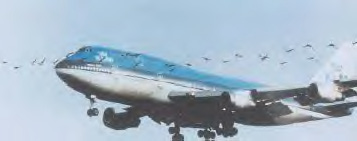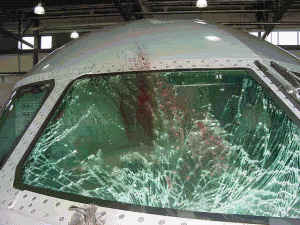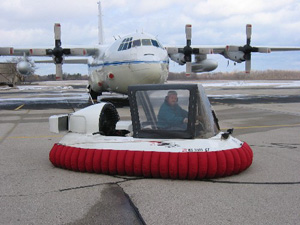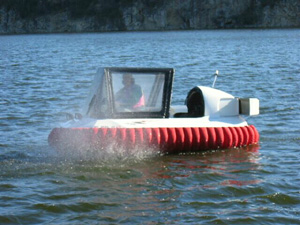Hovercraft
eliminates aviation threat at Batten International
Airport
April 2005
HoverWorld Insider
The problem

A 747 flies through a formation of Canadian
geese.
Photo courtesy Bird Strike Association, Inc.
|
Orville and Wilbur Wright mastered in 1903 what
birds have been doing naturally for more than 100
million years. Since then, the skies have become
too congested for comfort. Today, as the Christian
Science Monitor wrote with wry humor in 1999, the
feathers are flying in a flurry of bird-aircraft
face-offs.
The problem, however, is no laughing matter. From
1990 to 2004, more than 56,000 bird-aircraft strikes
were reported to the U.S. Federal Aviation Administration;
the agency estimates this to be only 20% of the
number that actually occurred.
According to the FAA and the Bird
Strike Association, Inc. , a trade association
representing the Bird-Aircraft Strike Hazard (BASH)
management industry, bird and wildlife strikes to
aircraft worldwide cost military and commercial
aviation more than $1 billion a year, and more than
400 people have been killed in the last 20 years
in bird-aircraft collisions.
The history
Calbraith Rodgers, the first person to fly across
the continental USA, was ironically also the first
to die as a result of a bird strike.
More recently:
• In 1991 the pilot of a Learjet was killed
over Cincinnati, Ohio when a loon crashed through
his windshield.
• In 1995, a U.S. Air Force AWACS plane struck
three dozen geese at Elmendorf Air Force Base in
Alaska, killing all 24 passengers. That same year,
a small jet carrying then-House Speaker Newt Gingrich
ran off a runway in northern Michigan after hitting
four geese; a bird-plane incident during takeoff
in Australia cost Qantas Airlines $8 million; and
an Air France Concorde sustained more than $7 million
in damages when it struck Canadian geese while landing
at New York's John F. Kennedy International Airport.

Damage sustained from aircraft collision with a single turkey vulture.
Photo courtesy Bird Strike Association, Inc.
|
The culprit
Canadian geese are a large contributor to this worldwide
aviation hazard. Their numbers have exploded at
an alarming rate; an estimated 4.3 million Canadian
geese now live in the United States and Canada,
and the once migratory bird has become a year-round
resident hazard at airports. Compounding the problem,
Canadian geese are protected under the Migratory
Bird Act, which prohibits most mitigation efforts
that would harm the geese.
Aviation Today reported in 1999 that although an
individual goose can weigh more than 12 pounds,
no aircraft turbine engine is designed to withstand
the impact of birds weighing more than eight pounds.
A flock of geese can cause catastrophic engine failure.
Aviation officials calculate that a 12-pound Canadian
goose, struck by a 150 mph aircraft at liftoff,
generates the force of a 1,000 Lb (454 Kg) weight
dropped from a height of ten feet (3M).
The hovercraft solution
John H. Batten International Airport in Racine,
Wisconsin USA is only one of thousands of airports
worldwide who have tried one unsuccessful solution
after another on the Canadian goose dilemma. Airports
are often located near wetlands, where federally
protected birds proliferate.
But unlike other airports, many of whom spend hundreds
of thousands of dollars per year on bird mitigation
efforts, Batten Airport has the distinction of discovering
a solution that works - a hovercraft – for
a one-time cost of around $10,000.

Batten Airport Assistant Manager Mike Loew
pilots the airport's hovercraft.
|
Hovercraft are frequently the ideal solution where
geographic and climatic conditions prohibit the
use of other vehicles. Such is the case at Batten
Airport, the largest private-owned airport in the
United States. The airport is located adjacent to
Quarry Lake Park, with an 18-acre, 90-foot deep
lake right at the end of the runway.
Airport Manager David Mann explains that because
of its depth, Quarry Lake is one of the last bodies
of water in the area to freeze, "More than
5,000 geese at a time flock to Quarry Lake when
all the other ponds and lakes are frozen. And all
these geese come and go right through the approach
of the runways. It's a very serious problem. The
area is protected from wind and rain by cliffs,
and with all those warm bodies churning up the water,
it further prevents it from freezing solid,"
says Mann, "It's like a bus shelter for birds."
The airport's hovercraft is a pre-owned 52-horsepower
Neoteric
Hovercraft Questrek™ and its sole
use at Batten is to evict the resident geese. "It's
the safest thing we could come up with," says
Mann, "This is the only way we can safely get
out there with those geese. And the beautiful part
is, it's working!"
"What we did with the hovercraft," he
explains, "is just go out and run them off.
There are two country clubs adjacent to the quarry,
and as soon as the hovercraft persuaded the geese
to leave, they would move to the country clubs who
would use their dogs to chase them off, so they'd
come back to the quarry - where we'd be waiting
on them with the hovercraft."
After several days of chasing the geese back and
forth, Mann says it allowed Quarry Lake to freeze
and the geese finally decided to move to a better
location. The hovercraft worked so well that after
a few days they didn't even need to start it up:
"After five days or so, we would just park
the hovercraft on the edge of the lake and the geese
would fly over, see it sitting there, and leave."
Mike Loew, Assistant Airport Manager and pilot
of the hovercraft, reported in February after the
hovercraft's first season of use, "I've been
on water, ice and land with no problems. The geese
don't like the hovercraft at all. We hardly have
any geese left!"

Mike Loew, Batten Airport Assistant Manager/Hovercraft
Pilot:
"We hardly have any geese left! |
The hovercraft has been a welcome solution to a
long-standing threat to aircraft at Batten Airport,
who has a history of bird strikes. Just prior to
the purchase of the hovercraft, an approaching jet
was "right at the critical point, around 200
feet, where you either see the runway or you don't,"
says Mann, "and the pilot decided to pull up.
He put the power up and went right through a flock."
After the collision with the geese, the pilot was
forced to fly to another airport without knowing
whether or not the aircraft had been damaged.
"We've had other situations where aircraft
on approach have been forced to abort because of
a flock of geese in the way," Mann continues,
"And a few years back a goose crashed through
the windshield of a single engine plane. It landed
in the cockpit and cut up the pilot pretty badly."
The geese pose not only a safety threat, but a
financial threat as well. Mann says that Batten
Airport has suffered thousands of dollars of damage
to aircraft de-icing systems "due to beaks
and such impacts."
Discarded solutions
Aviation officials worldwide are intensely focused
on the hazards posed by geese and other birds, and
have investigated a wide variety of mitigation methods.
The U.S. Federal Aviation Administration has conducted
ongoing experiments to find what might make airports
unattractive to birds, including the use of model
airplanes, recorded sounds of birds in distress,
fireworks, blank gunshots, flashing lights, cars
equipped with loudspeakers and chemical repellents.
Airports have also used border collies to frighten
geese away.
In 2004, O'Hare International Airport in Chicago,
Illinois began using propane cannons, paintball
guns, and a laser-beam gun to scare away bird flocks,
as well as a series of hazing machines. The devices
spray a grape-scented chemical cocktail called methyl
anthranilate. According to Richard Dolbeer, national
coordinator of airport wildlife services at the
U.S. Department of Agriculture, "The grape
flavoring acts as a repellent, like a bird tear
gas. Methyl anthranilate is actually a non-toxic
food flavoring that is used in grape Kool-Aid and
grape bubble gum, but birds find it very aggravating."
Batten Airport investigated many of these methods
before discovering that the hovercraft was a better
solution. "Grape Kool-Aid actually works well
in small ponds," Mann says, "but I'm afraid
we don't want to fill Quarry Lake with Kool-Aid."
The airport also tried both a remote control airplane
and a remote control helicopter, "but we couldn't
fly either of them as far away from us as the lake
is big. Once they get so far out, they're very hard
to fly."
Another proposal considered was to string wires
across the lake to discourage the geese from landing.
That idea was discarded because there was no way
to prevent people from climbing on the wires and
possibly injuring themselves.
Officials also considered shooting loud noises
into the quarry to spook the birds away, but that
idea was rejected because Mann didn't want to disturb
the residents around Quarry Lake Park. The hovercraft,
he says, generates enough noise to disturb the geese,
but not enough to disturb the residents.
The hovercraft is working so well, Mann believes,
due to "the combination of the noise and the
ability to just get us out there with the geese
at their level. We couldn't do this in any other
vehicle." Since Quarry Lake is fully or partially
frozen so much of the year, a boat was not a viable
option.
Shooting the geese was out of the question. In
addition to a public outcry against the idea, since
geese are protected under the Migratory Bird Act,
the U.S. Department of Agriculture would not permit
the airport to shoot the birds.
Assisted by the Department of Natural Resources
and the Department of Agriculture's Wildlife Services,
Batten Airport and Muskegon County officials worked
several years to find a solution that was both affordable
and agreeable to the public.
"The hovercraft idea came from the Department
of Agriculture," Mann explains. The Department
of Natural Resources actually offered to help fund
the hovercraft's purchase, but applying for a federal
grant was a lengthy process. Mann felt "The
matter was serious enough that I went to the airport
board of directors for the money. We were getting
strikes and I couldn't wait a year, maybe two, to
get rid of the hazard caused by all these geese
coming and going right through the approach of the
runway."
Safer skies, cleaner water and a healthier
bottom line
Canadian geese can also pose a health threat wherever
they gather, and the situation at Batten Airport
is not an exception. Quarry Lake is a mecca for
scuba divers and one of the finest outdoor swimming
and beach facilities in the Midwest. But the Canadian
geese have tainted its reputation.
In addition to endangering aircraft, the birds
have polluted the water and the beach with droppings.
It is estimated that one goose produces 1-2 pounds
of droppings a day. With a plague of 5,000 geese
on the lake, it's no wonder that the once clear
water became murky, making the lake unusable to
divers and undesirable to swimmers. The Racine County
Sheriff Department's Dive Team was forced to move
its regular practices to another location, and the
Department of Natural Resources instituted a water
quality study for possible negative health effects.
Mann says the hovercraft has offered a solution
for not only the aircraft hazard, but for the health
hazards as well. "It will make the fishing
a little better, the swimming a little better, and
I know it will make the skies safer."
Safer skies, cleaner water, and a healthier bottom
line – because now it won't be necessary for
Batten International Airport to spend hundreds of
thousands of dollars each year to keep the geese
away. One little pre-owned hovercraft is taking
care of it all. |